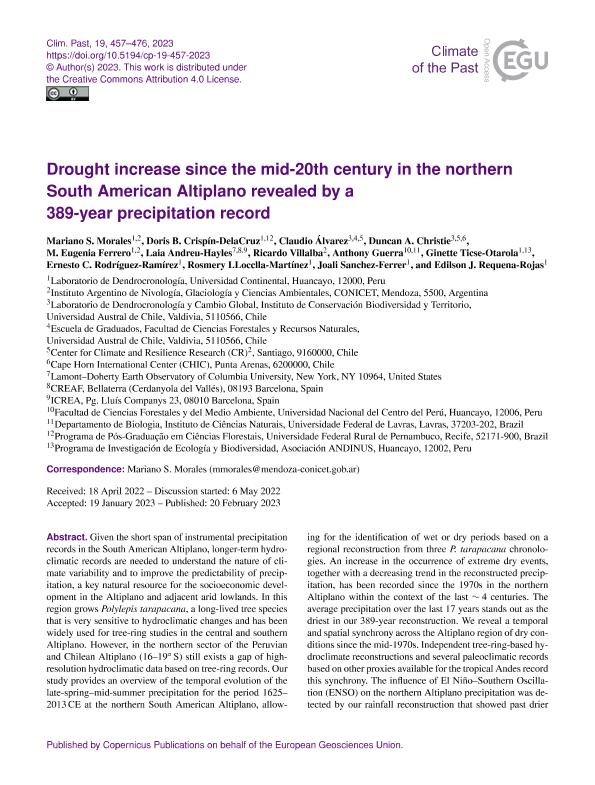Artículo
Drought increase since the mid-20th century in the northern South American Altiplano revealed by a 389-year precipitation record
Morales, Mariano Santos ; Crispín Delacruz, Doris B.; Álvarez, Claudio; Duncan, A. Christie; Ferrero, Maria Eugenia
; Crispín Delacruz, Doris B.; Álvarez, Claudio; Duncan, A. Christie; Ferrero, Maria Eugenia ; Andreu Hayles, Laia; Villalba, Ricardo
; Andreu Hayles, Laia; Villalba, Ricardo ; Guerra, Anthony; Ticse Otarola, Ginette Vilma Alicia; Rodríguez Ramírez, Ernesto C.; Llocclla Martínez, Rosmery; Sanchez Ferrer, Joali; Requena Rojas, Edilson Jimmy
; Guerra, Anthony; Ticse Otarola, Ginette Vilma Alicia; Rodríguez Ramírez, Ernesto C.; Llocclla Martínez, Rosmery; Sanchez Ferrer, Joali; Requena Rojas, Edilson Jimmy
 ; Crispín Delacruz, Doris B.; Álvarez, Claudio; Duncan, A. Christie; Ferrero, Maria Eugenia
; Crispín Delacruz, Doris B.; Álvarez, Claudio; Duncan, A. Christie; Ferrero, Maria Eugenia ; Andreu Hayles, Laia; Villalba, Ricardo
; Andreu Hayles, Laia; Villalba, Ricardo ; Guerra, Anthony; Ticse Otarola, Ginette Vilma Alicia; Rodríguez Ramírez, Ernesto C.; Llocclla Martínez, Rosmery; Sanchez Ferrer, Joali; Requena Rojas, Edilson Jimmy
; Guerra, Anthony; Ticse Otarola, Ginette Vilma Alicia; Rodríguez Ramírez, Ernesto C.; Llocclla Martínez, Rosmery; Sanchez Ferrer, Joali; Requena Rojas, Edilson Jimmy
Fecha de publicación:
02/2023
Editorial:
Copernicus Publications
Revista:
Climate of the Past
ISSN:
1814-9324
e-ISSN:
1814-9332
Idioma:
Inglés
Tipo de recurso:
Artículo publicado
Clasificación temática:
Resumen
Given the short span of instrumental precipitation records in the South American Altiplano, longer-term hydroclimatic records are needed to understand the nature of climate variability and to improve the predictability of precipitation, a key natural resource for the socioeconomic development in the Altiplano and adjacent arid lowlands. In this region grows Polylepis tarapacana, a long-lived tree species that is very sensitive to hydroclimatic changes and has been widely used for tree-ring studies in the central and southern Altiplano. However, in the northern sector of the Peruvian and Chilean Altiplano (16-19°S) still exists a gap of high-resolution hydroclimatic data based on tree-ring records. Our study provides an overview of the temporal evolution of the late-spring-mid-summer precipitation for the period 1625-2013 CE at the northern South American Altiplano, allowing for the identification of wet or dry periods based on a regional reconstruction from three P. tarapacana chronologies. An increase in the occurrence of extreme dry events, together with a decreasing trend in the reconstructed precipitation, has been recorded since the 1970s in the northern Altiplano within the context of the last ∼4 centuries. The average precipitation over the last 17 years stands out as the driest in our 389-year reconstruction. We reveal a temporal and spatial synchrony across the Altiplano region of dry conditions since the mid-1970s. Independent tree-ring-based hydroclimate reconstructions and several paleoclimatic records based on other proxies available for the tropical Andes record this synchrony. The influence of El Niño-Southern Oscillation (ENSO) on the northern Altiplano precipitation was detected by our rainfall reconstruction that showed past drier conditions in our study region associated with ENSO warm events. The spectral properties of the rainfall reconstruction showed strong imprints of ENSO variability at decadal, sub-decadal, and inter-annual timescales, in particular from the Pacific NIÑO 3 sector. Overall, the recent reduction in precipitation in comparison with previous centuries, the increase in extreme dry events and the coupling between precipitation and ENSO variability reported by this work is essential information in the context of the growing demand for water resources in the Altiplano. This study will contribute to a better understanding of the vulnerability and resilience of the region to the projected evapotranspiration increase for the 21st century associated with global warming.
Archivos asociados
Licencia
Identificadores
Colecciones
Articulos(IANIGLA)
Articulos de INST. ARG. DE NIVOLOGIA, GLACIOLOGIA Y CS. AMBIENT
Articulos de INST. ARG. DE NIVOLOGIA, GLACIOLOGIA Y CS. AMBIENT
Citación
Morales, Mariano Santos; Crispín Delacruz, Doris B.; Álvarez, Claudio; Duncan, A. Christie; Ferrero, Maria Eugenia; et al.; Drought increase since the mid-20th century in the northern South American Altiplano revealed by a 389-year precipitation record; Copernicus Publications; Climate of the Past; 19; 2; 2-2023; 457-476
Compartir
Altmétricas



